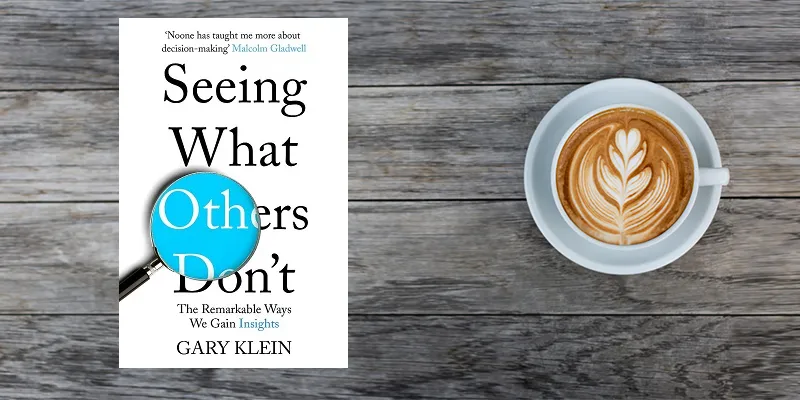The five types of triggers for insights – and how you can spur innovation in your own organisation
Insights are at the heart of innovation and decision-making in sectors ranging from science and business to education and defence. This compelling book provides useful frameworks on triggers, impacts, obstacles, and enablers to getting more insights.
Looking for ways to improve your creativity on the personal and professional front? Gary Klein’s book Seeing What Others Don't: The Remarkable Ways We Gain Insights will get you going on the journey with a wealth of examples and frameworks.

Dr Gary Klein, a senior scientist at MacroCognition, was instrumental in founding the field of naturalistic decision making. He has worked in the defence and business sectors, and is the author of Sources of Power: How People Make Decisions; The Power of Intuition; Working Minds: A Practitioner's Guide to Cognitive Task Analysis; and Streetlights and Shadows: Searching for the Keys to Adaptive Decision Making.
Gary draws on personal and news media anecdotes as well as historical and scientific books to show how insights can transform daily activities and even the world itself. His examples feature scientists, business people, firefighters, police officers, soldiers, and family members. The focus is on insights and decision-making in naturalistic settings, as compared to laboratory settings for psychology tests using artificial puzzles.
Drawing on 120 cases, the material is spread across 280 pages and is written in a conversational style, but could be condensed in a pithier form. There are a few process diagrams and models, but more illustrations or tables would have helped.
Here are my key takeaways from this compelling book, summarised as well in Table 1 below. See also my reviews of the related books Quirky, Messy, InGenius, Sensemaking, A Beautiful Constraint, How to get to Creative Ideas, The Creative Curve, and The Art of Creative Thinking.

Context
Gary builds on and differs from existing frameworks for insights, such as the ‘Stages of Control’ model of Graham Wallas. As described in his book The Art of Thought, the four-stage model of insight is preparation, incubation, illumination and verification.
However, Gary counters that expertise and mindset are more relevant than preparation (some insights are accidental). Sometimes, insights occur without much of an incubation period. Insights may even occur when there is no impasse faced.
Other related research by Danny Kahneman (Thinking, Fast and Slow) distinguishes between fast and intuitive thinking (System 1) and slower, more critical, analytical and deliberate thinking (System 2).
Gary defines insights as the discovery of new patterns, and intuition as the use of patterns that are already learned. An interesting feature of getting insights is that even others with access to the same information and in the same context may not achieve the same insight.
Some insights are sudden (‘aha’ moments and flashes), others are gradual (slow build-up of hunches). It can help to postpone deeper research for some time so as to avoid prior biases.
“Recognitional decisions depend on decades of experience to build up hundreds and thousands of patterns,” he explains, drawing on examples from the military and oil exploration. Knowing what is typical behaviour helps spot unusual variations. At the same time, too much experience can led to “automaticity” and mindless activity.
“Stories are a way we frame and organise the details of a situation,” Gary says; other ways are maps and drawings. Stories depend on a few core beliefs or anchors that are generally stable and frame the way details are interpreted; these anchors can change with the addition of new information and analysis.
Impacts of insights
Insights lead to an unexpected shift to a better story, which describes past events or leads to future impacts. They lead to new beliefs that are more accurate, comprehensive and useful. They change our perceptions, feelings, mindsets, desires, goals and behaviours, Gary explains.
Insights create a sense of closure and a feeling of certainty. There are strong emotional and even aesthetic reactions to the beauty of the insight. Insights can strengthen attitudes of curiosity and even suspicion, skepticism, and outrage.
The flows and impacts of insights are also captured in Gary’s book in the form of quotes such as the following:
Insight cannot be taken back. You cannot return to the moment you were in before. – Hilary Mantel
The greatest obstacle to knowledge is not ignorance; it is the illusion of knowledge. – Daniel Boorstin
You can’t depend on your eyes when your imagination is out of focus. – Mark Twain
Types of insights
Part I of the book focuses on the five types of triggers that lead to insights: connections, coincidences, curiosities, contradictions, and creative desperation. Some of these triggers can act together as well.
Connecting the dots helps solve a problem by exposure to more ideas. However, this also involves being able to weed out “non-dots” and even “anti-dots,” according to Gary. “Insights don’t count for much if we can’t translate them into action,” he cautions.
Military examples include the Battle of Taranto between Britain and Italy in 1940, using air planes launched from carriers to attack enemy battleships. The Japanese drew insights from this incident to attack Pearl Harbour; the Americans also had the same insights but could not mount defenses on a proper scale.
“The mother of all scientific insights,” according to Gary, is Darwin’s theory of natural selection of species, for which an insight trigger was an essay on population competition by Malthus.
Coincidences can provide early warning signs about a new pattern. Examples include astrophysicist Jocelyn Bell Burnell, who helped her advisor win a Nobel Prize when she stumbled upon a coincidence: repetitive patterns of signals from pulsars.
Curiosities are sparked by a single event or observation, rather than a repeated pattern. Examples include Wilhelm Roentgen’s discovery of X-rays and Russell Ohl’s discovery of electrical flow variations in silicon (leading to diodes, transistors, and silicon solar cells).
Contradictions can arise between evidence and belief, and lead to the rejection of the prevailing wisdom of the time. They are spurred by contrarians and sceptics who doubt and disbelieve the currently dominant story. “We are told that to make discoveries, we have to keep an open mind. However, a suspicious mind can also pay off,” Gary observes.
Examples include analysts who warned about shoddy home loan practices that led to the 2007-2008 financial crash. The bubble grew because of the mistaken belief that house prices would always increase.
“Good stories are hard to resist, even when they are wrong,” Gary cautions. For example, John Snow was sceptical about the miasma theory of cholera (ie. spreading from noxious air). He eventually found that it was caused by contaminated water, after examining data and maps of affected areas.
Over time, growing discrepancies lead to a paradigm shift, as explained by physicist Thomas Kuhn in The Structure of Scientific Revolution. Examples include Einstein’s theory of special relativity, which held that space-time was variable and not constant as earlier described.
Creative desperation arises when trying to find a way out of an inescapable emergency. A flexible mind is needed here to cast away existing solutions and assumptions, eg. Wagner Dodge using fire to fight fire by creating patches of burnt grass in the face of advancing flames. Another example is Napoleon driving away the British from Toulon by cutting supply lines elsewhere instead of attacking them at the port.
The connection, coincidence and curiosity paths create new anchors or beliefs and combine them with others; the contradiction path uses a weak anchor to rebuild the story; and the creative desperation path discards a weak anchor. Gary defines this as the Triple Path Model of insight.
Obstacles to insights
Part II of the book focuses on obstacles to insights at the individual and organisational level. These can include stupidity, forgetfulness, lack of alertness, delusion, flawed beliefs, inexperience, passivity, over-confidence, and rigid reasoning styles.
“Experience isn’t just about having the necessary knowledge. Experience is about how we use our knowledge to tune our attention,” Gary explains. Attuning and sensitisation can help open the mind to the possibility of new insights. “An active attitude leads to persistence,” he adds. It helps deal with failure and stay the course despite some initial challenges.
Flawed theories can explain away or distort evidence that could be used for new insights. A concrete reasoning style prevents people from engaging in hypothetical speculation and imagining alternative universes. People with playful minds enjoy such speculation, Gary emphasises.
Watson and Crick “scooped the rest of the research community” in their discovery of the double-helix model of DNA. Some competitors had the flawed belief that protein carried genetic code, or were not active in seeking out the functional implications of DNA structure.
Enablers of insights
Part III of the book discusses how to improve the flow of insights into oneself, other people, and organisations. Understanding the five types of insight triggers helps create openings for discoveries.
Seeking others’ perspectives can help unearth your own contradictions and blocks, Gary explains. Other suggestions are increasing diversity and density of idea exposure, connecting to creative people, and fostering serendipitous collision of ideas.
Critical thinking approaches also help (particularly to unearth flaws and contradictions), but prolonged concentration should be interspersed with periods of relaxation. “Playful daydreaming” can also open up uncommon connections.
To help others get insights, Gary advises tapping into their desire for insights, understanding their blocks, and guiding them towards coming up with insights on their own. Emergence rather than push activities are recommended. This calls for compassion, empathy and appreciative inquiry.
For example, sports coaching can involve asking players to imagine and predict how the ball moves, rather than directly describing actions and moves. Teachers can let students participate in peer activities to surface learnings, rather than via direct instruction.
Insights in organisations
Performance improvement in organisations comes from a combination of fewer errors and more insights. However, most managers tend to focus excessively on preventing mistakes since errors are visible, costly, embarrassing, and damaging to the ego and to the brand.
Many business processes software tools are not designed to promote exploration but adhere to rigid processes. Focusing on “relevant” data may be a challenge when new items and categories of information emerge. Search engines should show not just directly relevant results but also challenging and even uncomfortable items, Gary suggests.
Organisations seem to prefer predictability and perfection over the diversions and disruptions that insights entail. Opening up the possibility of errors during creative activities is seen as risky and wasteful.
Companies tend to excessively rely on checklists and procedures; speculative and dissenting behaviours are discouraged. Excessive embracing of Six Sigma can lead to loss of creativity and innovation, and companies like 3M scaled it down.
While the above activities should be seen in the proper context of mature, standardised and mission-critical processes, there should also be room for questioning the shelf-life of assumptions and beliefs. Gary calls for a balance between excessive control and the quest for new insights. Unfortunately, many companies bury, stifle or ignore insights; this also leads to junior employees self-censoring their insights.
For example, FBI agent Kenneth Williams noticed a contradiction: several Arab men were taking flying courses in Phoenix, but did not want to practice takeoffs and landings. He issued a terrorist alert, but the FBI refused to act on it, thus becoming unable to prevent the 9/11 attacks.
Companies should actively promote generation, publication and documentation of insights, eg. through methods like storytelling. A team of “insight advocates” can help practices like knowledge management. “Insight filters” should be loosened to allow more free flow, and there should be channels and forums for junior employees to appeal to higher authorities if their insights are ignored, Gary recommends.
Models like the “ambidextrous organisation” help pursue efficiency for mature products while also encouraging creativity in emerging sectors. “The trick is to keep the two approaches separate,” Gary advises, in terms of reporting structure, metrics, and even physical location.
Companies should also act on insights in a timely manner. Examples of successful business reinvention include IBM. In contrast, Kodak did not make the radical changes to move from film to digital photography (ironically, it was Kodak engineer Steve Sasson who developed the first digital camera in 1975).
Encyclopedia Britannica (EB) also came out with a CD-ROM edition in 1989, but it was overpriced and not promoted properly. It was outflanked by Microsoft Encarta in 1993. Gary feels that anyway, EB would have found it tough to compete with Wikipedia.
In the final chapter, Gary explains how the ancient Greeks even worshipped the human capacity for insight. They had nine goddesses or muses who were seen as sources of inspiration (a practice carried on today in the modern museum, ‘a place of the muses’).
“Having an insight is an act of creation,” Gary sums up. Insights can even be seen as magical in that regard. “That magic lives inside us, stirring restlessly,” he concludes.








